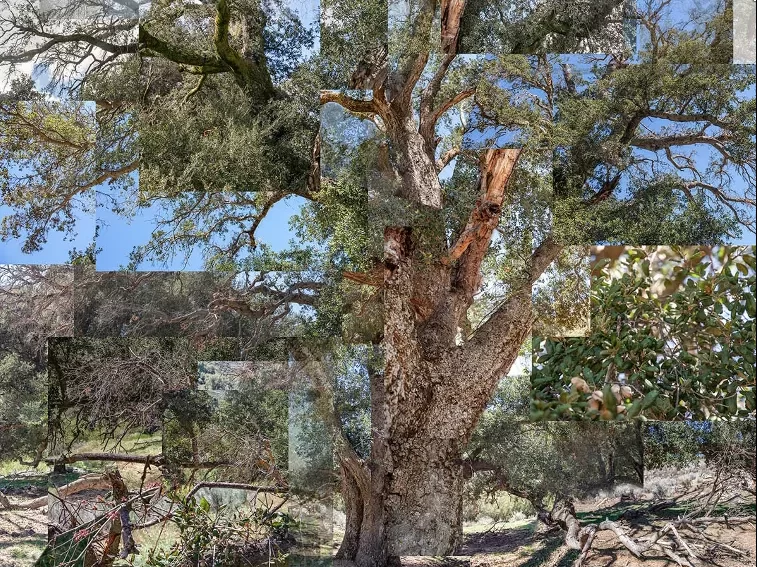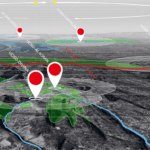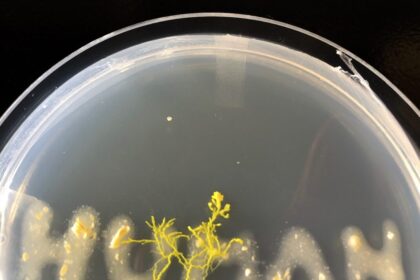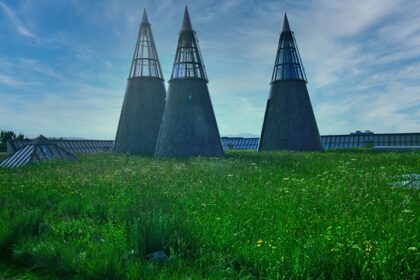Walking with Trees: Stories in Honor of Helen and Newton Harrison
Ruth Wallen
Introduction: An Offering of Gratitude
January 8, 2022
I give thanks to Kumeyaay as I walk on their ancestral, unceded lands.

Walking towards the old oak at the beginning of the Pine Valley Creek trail, about forty-five minutes from my home near downtown San Diego, I notice that her upper limbs look more naked than ever. I turn to the left of the tree, facing east, the direction of the rising sun and bow:
Dear oak what must you continue to endure? I am so grateful for your tenacity, that you are still standing, that I can greet you on my walks. Breath fills my lungs, streams downward through my feet to the ground below and upwards through the crown of my head to the sky above. As my breath streams out, I imagine it embracing you. A newly fallen branch, the leaves still green, lies at my feet. Oh, that I could breathe life into you.
I circle to the south and look up at the branches just above me. The whorls of twigs and leaves make magnificent patterns in the sky. I bow again. Oh tree, your beauty is stunning.
Moving to the west, the side of the tree where the leaves are most abundant, the smell of profuse greenery fills the air. The gentle scallops of your ovular coast live oak leaves end in sharp points. However, from a distance it is as if they envelop you in soft lace. Oh oak, that embodies such toughness and grace, I bow to you.
Passing the concrete steps on the ground, all that remains of an old dwelling, I turn to the north. Oh, dear oak, the settler that once lived here is long gone. I bow to your strength as you continue to endure not only the cattle that trample the ground as they feast on the grass at your feet, but the Goldspotted oak borers that are feasting on your inner bark.
Walking with Trees
For more than a decade I have been walking with trees. I have walked in the aftermath of drought, bark beetles, introduced boring beetles, and two conflagrations, in 2003 again in 2007, the first of which, although only one of four fires burning simultaneously in San Diego county, was the largest ever in California until 2017. I started near my home in San Diego, repeatedly visiting many locales, from the coastal chaparral and Torrey pines to the inland mountains. I started gradually, without a plan, wanting to understand, to be attentive to the ecological changes that were occurring. It was not with any particular intention that I returned to the same places, year after year, but simply to be present and learn from the trees. The trees called to me. Walk among us. Look. Listen. Be attentive to feeling. Bear witness. Record what you see. Let tears flow. In honor of Helen and Newton Harrison, I share these stories of my experiences.
Homage to Helen and Newton Harrison
I first met the Harrisons years ago at their reading of the “Meditations on the Sacramento River, the Delta and the Bays of San Francisco,” at the San Francisco Art Institute. Inspired by their work, and their observation that the water quality legislation of the seventies led to a flourishing of marine life that paradoxically was eating away at the old piers and ships hulls that many wished to preserve in the San Francisco Bay, I decided to drop wooden sculptures in the bay and see for myself, recording the growth on the wood at monthly intervals by means of macrophotography. A year later, when I was offered a residency at the Exploratorium to work on the project, I wrote to the Harrisons thanking them for their inspiration.[1] I still recall the letter their daughter Joy wrote back—my parents invite you to come visit and stay with them in our home in San Diego when you come. What extraordinary generosity! I took them up on their invitation eventually moving to San Diego to study with them in the MFA program at UCSD.
There are no words to express my gratitude for the innumerable conversations, for their mentorship and friendship over the years. Decades ago, Newton told me that my work centered around being a guardian of place. I offer these stories of walking with trees as a token of my gratitude and respect, as I follow their example of joining in the conversation of place, cultivating relationship and care, listening deeply to the stories of place’s own becoming, and honoring the power of metaphor, poetry, and story to seed new conversations that will drift where they will.
A Tightening Noose
Let’s start with a story of collaboration. In 2015 I was invited to take part in Weather on Steroids, an exhibition that paired artists with scientists at Scripps Institute of Oceanography. Intrigued that tree rings were often used to ascertain the climate of the past, I imagined using tree rings to visualize potential climates of the future. After considerable research to ascertain which climatic variables best correlated to tree growth and with the help of many scientists at Scripps and beyond, it was David Pierce who supplied data from his models of soil moisture that I used to diagram Torrey pine tree rings.[2] This index, derived from thirty-two different climate models from around the world, was the best available data set at the time that combined the effects of temperature and moisture and could be extrapolated for local conditions. While older research on Torrey pines correlated growth with precipitation alone, it was essential to account for both moisture and heat because as temperature rises, trees require more water. Furthermore, while all climate models indicated that temperatures will rise, predictions of future precipitation varied between different models, so using an aggregate of several models accounted for many possible relationships between both variables.
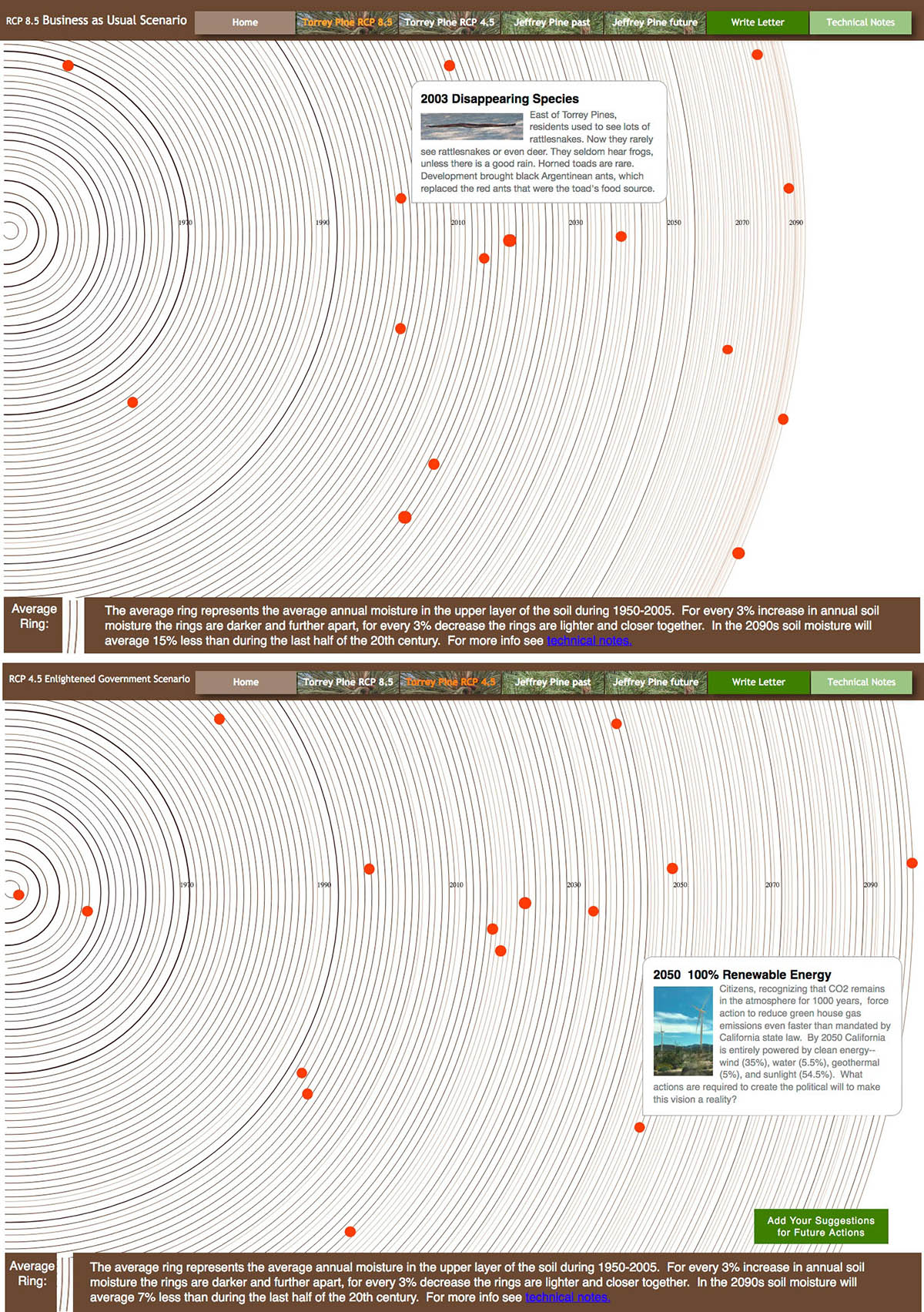
To create the visualization of tree rings for the coastal Torrey pine, for each 3% change in average annual moisture, as soil moisture increases the tree rings get thicker and further apart, but as soil moisture decreases, the rings become thinner and closer together. (Note that for the purposes of visualization the diagrams don’t account for the fact that as the circumference of a tree increases, generally the rings become closer together.) The comparison of the tree ring diagrams constructed from the data of two commonly used scenarios of future climate, the “enlightened government,” RCP 4.5, and the “business as usual,” RCP 8, are illuminating. By 2100, the circumference of the tree growing under the “business as usual” climate scenario, is much smaller than the tree growing under the “enlightened government” scenario, which assumes that humanity starts acting quickly, finally, to lower greenhouse gas emissions. Note also how much closer together the tree rings are in the “business as usual” scenario by the later part of this century than they are at present, true also to a lesser extent in the enlightened government scenario. The tree rings are like a tightening noose.
The conditions in the southern Sierras illustrated how much the trees have already been impacted. Visiting Alta Sierra, the southern-most point of the Sierras, in 2016 was shocking. Mountainsides were dotted with rust-covered conifers suffering from the hot drought of 2012-2014. Researchers suggested that although droughts were periodic occurrences in California, the impact of the lack of water was made 36% worse by rising temperatures. [3] Why I wondered was there no public outcry when about 100 million trees perished in California in the first half of the last decade?
The tree ring diagrams were exhibited on touch screens placed in faux tree stumps. When viewers pressed one of the many orange dots on the tree rings, dialogue boxes popped up that showed events that either have occurred or might occur in the future. One dot took viewers to an animation of the predictions of climate scientist Richard Somerville who said in 2015 that humanity needed to decrease energy use by 5.7% a year, but that by 2020 we would need to decrease energy use by 9% to stay within a two degree C temp rise. It is now 2022, and action has yet to be taken.[4] The noose continues to tighten.
Walking with Oaks at Pine Valley Creek
Let’s return to Pine Valley Creek, where I began this journey. Not only humans but also trees are suffering from pandemics from invasive species brought from around the world, all made worse by on-going drought. I invite you join me on one of my walks to sit with the oaks.
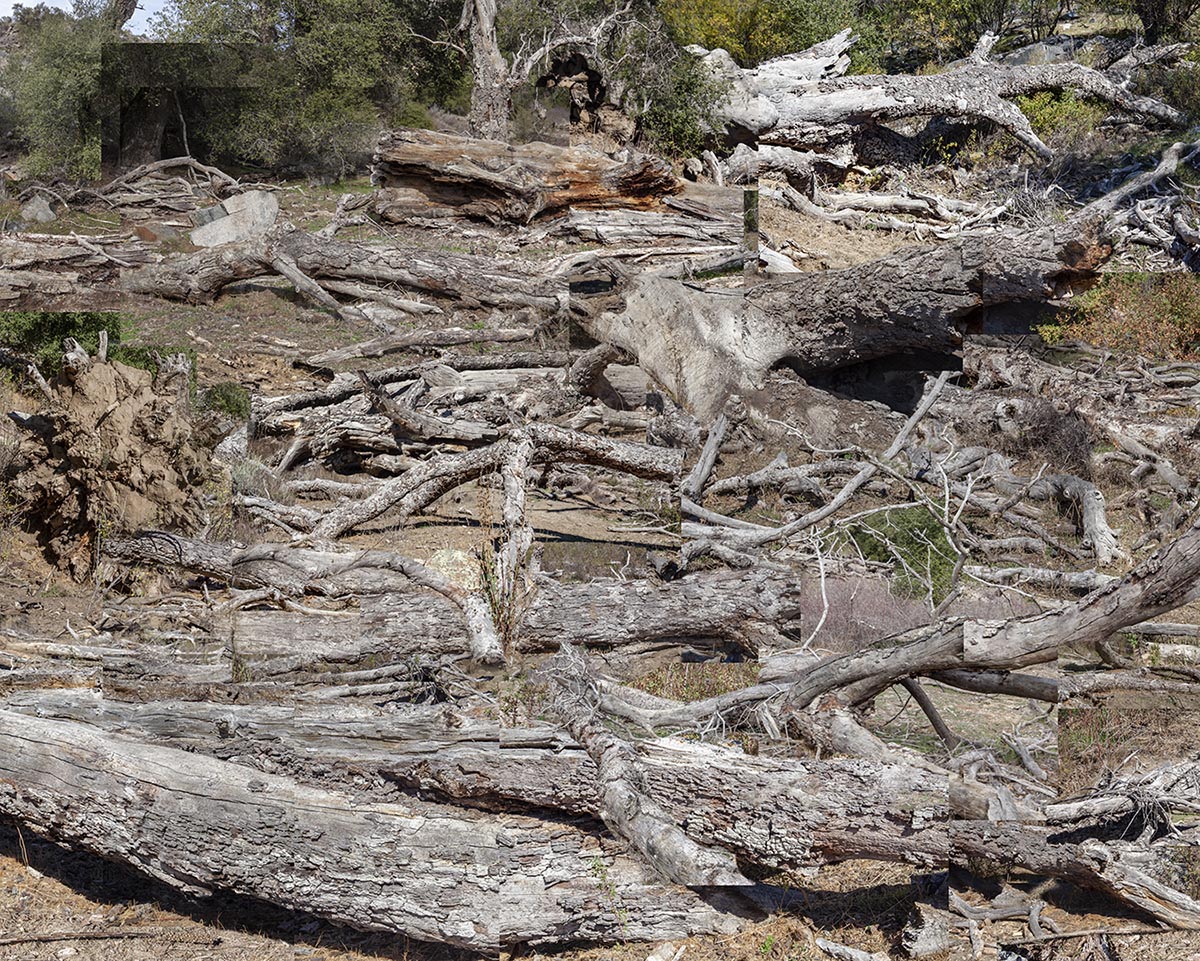
Jan 8, 2022
Bowing again, I turned north, to the charnel ground, passing the rows of scattered corpses. Almost two years ago at the start of the pandemic the brown logs felt so solid, flush with moisture, sprouting mushrooms, lichen and even blades of grass. Now they seemed dried, shrunken, tattered, lower to the ground.
Leaving the path, I found a place to sit in the middle of the field on a flattish rock with a lower step for my feet. I felt so naked in the middle of the field, sitting among a sea of skeletons, tossed about amid red prickly spines. I began meditation practice repeating the vow of the bodhisattva: “until the suffering of the three worlds is completely exhausted, I will courageously dedicate myself to the welfare of others.”
Almost two years ago at the start of that pandemic, could we have imagined that even after a vaccine was developed, holiday parties would be planned and cancelled, replaced with masks, vaccination restrictions, calls for everyone getting a booster, worries that hospitals would again be at the breaking point and that many would die alone, isolated from their loved ones?
The smaller trees still living by the banks of the creek, or on the slope on the opposite side of the meadow, know about collapse. The remains of their elders lie tossed about on the ground, the aftermath of the oak borer’s feast. Elderly humans are the most vulnerable to covid because their immune systems are weaker. However, the Goldspotted oak borers are attracted to the huge elders because they offer the richest bounty. The larvae feast on the cambium, the new wood that grows annually between the phloem and xylem, through which nutrients and water flow. Suzanne Simard has written so eloquently about the importance of mother trees, elders that nurture the next generation, passing nutrients, and information, including warnings of pests to their young through their roots.[5] How much were these elders able to pass on before they perished?
Even after death trees keep giving. I have returned to sit with them for years, as leaves dry and drop revealing a naked body, followed by falling twigs and then large branches as a tree is gradually reduced to a more elemental form. Through all of these stages the tree is still a vital presence in the community. The acorn woodpeckers who deposit acorns in the massive trunks, are only one of many birds, small mammals, and insects, that depend upon the snags or the fallen logs for food and shelter.
Fallen logs also hold more moisture than their surroundings. Just as in hugelkulture garden, a memorial to dying trees that Nina Karavasiles and I created at the California Center for the Arts, Escondido, where the buried logs, provided nutrients and held water to support a garden of pollinators.[6]
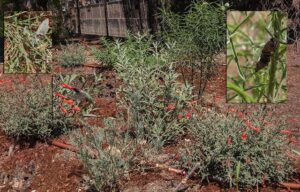
Witnessing the slow disintegration of these trees has been both heartbreaking and heart opening. This time of unraveling, this time when systems are on the verge of collapse, calls to attentiveness to decomposition as a vital part of the life cycle. Forest managers may call for the cutting of dead trees, to salvage some value from their timber before they seed large wildfires. But is this a blindness bred in a culture that only sees value in extraction and that wishes to avoid sitting with death? Instead of ignoring the fact that so many trees are dying, what might we learn from this process of decomposition?
In this time of winter, the continued presence of the pandemic demands that there is more work to be done, that we look deeper, that we pay attention to the process of death, decay and renewal. Decomposition is a kind of distillation as complex organisms returned to their elemental state where they may nurture future generations, whatever the forms of life emerge. Which aspects of human behavior—love, kindness or compassion, can serve to work with the darkness of collapsing systems?
An Apprenticeship with Grief
Since pandemic began, I have been visiting the oaks at Pine Valley Creek at least quarterly. I am grateful to be able to continue to return, to mourn their losses, share my love and learn from being in their presence. Francis Weller calls this an apprenticeship with grief.[7]
The starting point, the ground of my practice is similar to that of the Harrisons–attentiveness, which opens the heart to tremendous gratitude for the wonder, enchantment, and beauty of the living world. This opening to presence leads to empathy, or compassion, a recognition of the suffering of others. I prefer the term compassion because it implies a dissolution of the self/other dichotomy and a recognition of the inseparability of the complex systems of the life web. Furthermore, attentive presence involves an embodied cognition that honors not only the intellectual, but the sensual and emotional. In these times, learning to stay with difficult emotions is vital, as is the creation of public spaces and rituals to share the unfathomable sorrow and rage over current ecological devastation, emotions that can be a pathway to vulnerability, tenderness, wisdom, and love. The opening to presence also evokes the creation of potent metaphors, so central to ecological praxis, and the weaving of these metaphors into fresh narratives that express the workings of complex systems and spark imaginative conversation. These improvisations, and what the Harrisons term “conversational drift,” can engender new ways of being and doing—an ethos that is grounded in compassion and a transdisciplinary praxis that is committed to the well-being of the entire life web.
In addition to the Harrison’s my work is in conversation with many others including Martin Prechtel, Pauline Boss, Joanna Macy’s work that reconnects, and the three tenets of the Zen Peacemakers, which are vital to understanding the process of bearing witness to dying trees.
To the three tenets of the Zen Peacemakers, like Macy, I start by adding a fourth, the expression of gratitude.[8] I always begin my walks with a sensing of the vitality of the life web and an offering of gratitude for the wondrous world in which we live. As Martin Prechtel writes, in his most powerful book, The Smell of Rain on Dust: Grief and Praise, “Nine tenths of feeling bad about life is the inability to see the details of the natural magnificence”…. that surround us at any moment.”[9] Fully feeling the magnificent wonder of the living world is heart opening, an opening to love and to the ability to stay present with grief. As the title of Prechtel’s book implies, grief and love are intertwined; “grief is praise for those we have lost.”[10]
Form this experience of gratitude for the brilliance of the living world, I enter the conversation of place through deep listening, a listening without preconception, present to uncertainly, or in the words of the Zen Peacemakers, “not knowing.” The acknowledgement of gratitude and uncertainty sets the ground to walk, to bear witness, to be fully attentive to feeling, welcoming embodied, sensual knowing. I welcome whatever feelings do or don’t arise, aware that we live in a time of schizophrenic contradictions, in a culture that has banished death, in the words of Phillipe Aries, while many scientists warn of the sixth mass extinction.[11] I walk also with the awareness that it is the fear of feeling that can lead to despair and psychic numbing. Shielding ourselves from sadness, from the vulnerability or groundlessness that comes with loss, is also shielding ourselves from love. Ecological losses occur with increasing frequency. Renee Lertzman coined the term environmental melancholia” to describe the state of those who care deeply, but are “paralyzed to translate such concerns into action.”[12] In contrast acknowledging the pain of loss, welcoming grief, is active and essential to working with the ecological crises.[13]
I trust that staying present to grief, loss and tender heart will lead to “seeing with fresh eyes,” to quote Macy. With these eyes one can “go forth” and “take action.” [14] Pauline Boss’s latest book is entitled The Myth of Closure. Here she argues that even for acknowledged losses of friends and family, the idea of closure, of a set processes and interval mourning is a misleading myth, a myth that is magnified in the many ambiguous losses we face in contemporary society, from unresolved trauma after war or violence, to the many losses due to the pandemic or a changing climate. In response she poses six guidelines for resilience.[15] One of these is “finding meaning,” another “discovering new hope,” hope in the active sense, as described by Macy and Johnstone, as a practice, as a fresh vision for the future, of “what we aim to bring about,”[16] As I walk, the development of this vision is guided by a careful listening to what the place, the dying trees are trying to teach us.
Walking with Giant Sequoias
Grounded in this understanding of process, let’s walk with the giant sequoias in Giant Sequoia National Monument. Giant sequoias are astonishing trees, their massive trunks remarkably striking. Whereas the trunks of most trees, even the tall long-lived sugar pines, white firs and incense cedars with whom sequoias reside, taper as they grow upward, the trunks of mature sequoias rise from a huge base as a massive cylindrical mass that largely maintains its girth for hundreds of feet in the air. In comparison to their trunks, sequoia’s limbs are stubby but still as wide as the trunk of a typical tree. The largest sequoias are the most massive living organisms on the planet. They are also among the world’s longest living trees, some surviving for over 3000 years. As such they are extremely hardy, resistant to flames and pests. Meeting these trees for the first time since childhood, in 2019, was a most moving experience. I came to the southern Sierra concerned about their fellows–the pines, cedar, and fir that were dying of drought and beetles. But the presence of the sequoias was breathtaking. Requiring tremendous amounts of water, they tend to grow in the moistest locations. Hiking in a sequoia grove with lush meadows and flowing streams was a respite from the dry summer heat. Furthermore, even as some of their more susceptible neighbors were drying from drought, the sequoias themselves, the most heartly of trees, were largely unscathed, although by 2019 scattered reports of a few individual trees impacted by beetles were cropping up. As I delighted walking among the sequoias, I never imagined that so many of the trees I just met, that had survived for millennia, would go up in flames the next summer.
The story of the fire that struck the trees is one that is becoming increasingly familiar. Lighting struck several places in the national forest on August 19, 2020. Initially the fires were very small, but gradually merged into one massive conflagration that became known as the SQF Complex or Castle Fire. Then one day the winds picked up and the fire burned through twelve miles, past carefully constructed fire breaks and fire retardant, racing through the Freeman Grove and onto others, miles away. The fire continued into October, scorching 174,178 acres and twenty-two sequoia groves. One summer, one fire, and over a tenth of the total sequoia population destroyed.[17]
Bear Creek Trail, August 5, 2021
Two years ago, I had photographed extensively, focusing on the broad vistas of the mountainside on the opposite side of the gorge, which evidenced extensive tree loss. What would these mountainsides look like now?
As I started up the ridge line, the mountainside looked as it had two years ago. The steep slope below the trail and up the other side of the creek was largely green with patches of grey. Higher up the opposite slope, grey areas outnumbered the green, the grey from both an increasing number of dead trees as well as small rocky outcrops.
A short distance later, where it was possible to see further up the mountainside on the other side of the canyon, swathes of trees were brown, those that had not died of drought now killed by fire. Continuing up the ridge, the vistas grew bleaker. In some areas burnt foliage clung to the trees, but in other areas the steep slopes were lined tree skeletons that graded into rows of fragile black sticks. The fire had burned down the side of the canyon on which I stood as well. I walked past burnt oaks, conifers, and the tangled blackened branches of the chaparral. In places the manzanita and scrub oaks were still identifiable from their brown dead leaves. New green shoots sprung up from the base of the scrub oaks.
After maybe a couple of miles, the trail veered off the ridge to a flat plain once forested by black oaks and unidentifiable conifers. Everything here had burned. Leaves still clung to some of the oak trees and fresh whorls of green leaves sprouted at their bases. Thankfully someone had placed small rock cairns just at points when it seemed impossible to follow the trail any further.
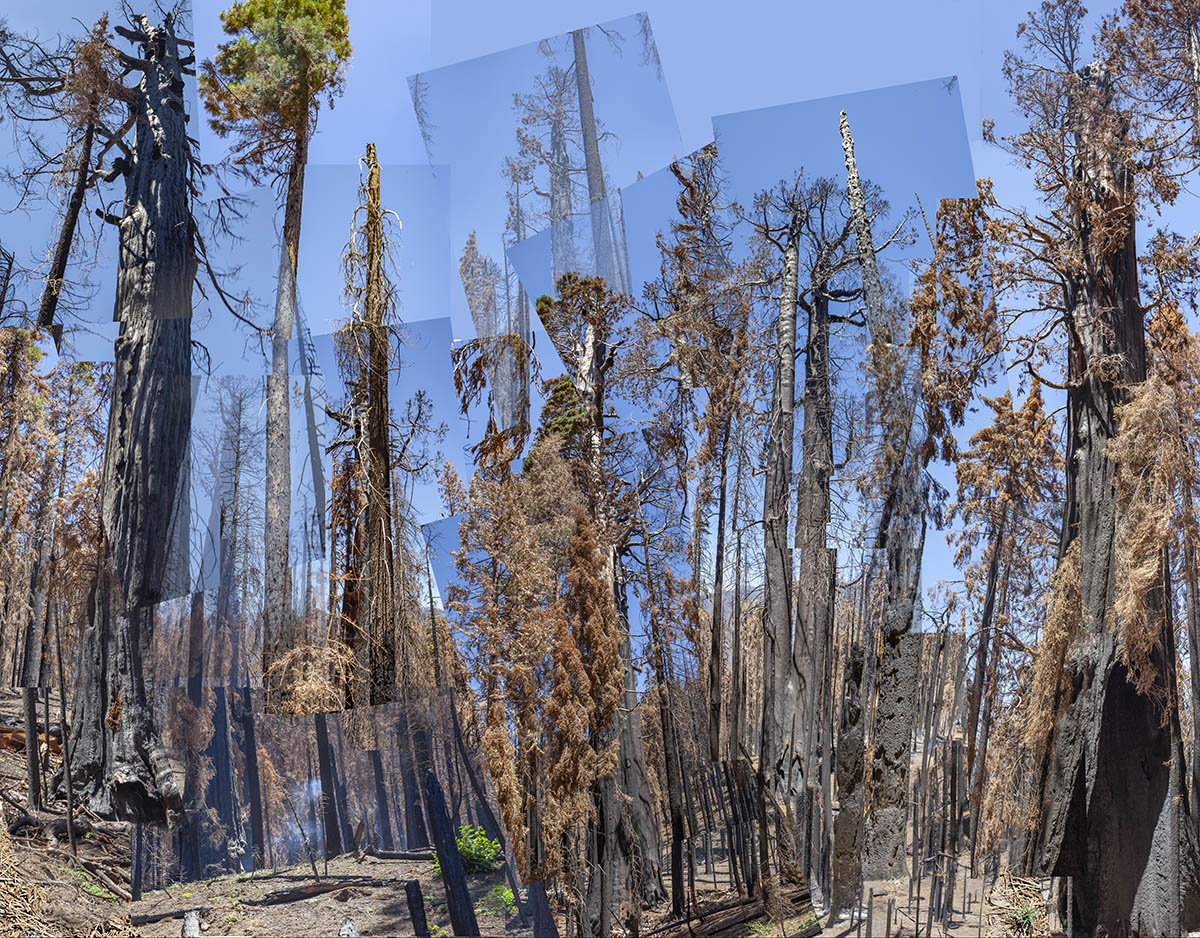
As the trail became steeper, the scene was bleaker. The tangle of bare branches gave way to thin black charred poles. Hiking over a rise, I came to taller poles. I imagined pines, fir and cedar but couldn’t tell which was which. Continuing on, I spied one stave that was much thicker than all the others. High up, a few stubs of branches jutted out to the sides. It looked like the top was lopped off, although a couple of thin blackened branches with bits of brown foliage remained, reaching upwards. I’d come to the McIntyre sequoia grove. Whisps of smoke wafted from the ground. Almost a year later, and the fire was still burning.
I stood in shock. A caldron of smoke, surrounded by towering blackness. These were the trees that survived countless fires, living for thousands of years. But all that was visible was blackness.
What had I come to? There was another sequoia near the smoke, actually two, a second behind the first. These two had many more branches, some still covered with clumps of foliage. I strained to no avail to find a hint of green, any indication that the tree might survive. To the left was another sequoia, completely black, the top of the tree blown off. Nearby stood thin ragged sticks, remains of much younger pines, cedars, or firs.
As I looked around for a trail, wondering if I should approach the smoke, I saw another sequoia, or should I say a thick, cylindrical mass, completely blackened and sheared at the top. Nearby stood the charred remains of more trees–sugar pines, the largest and tallest of the pines that can live for five hundred years or more, as well as the equally long-lived Jeffrey pine and cedar. Some of their trunks still bore hollows from previous fires. All of these trees, were also adapted to survive fire once they matured. But this fire burned hundreds of feet high, into their crowns, charring everything, the younger smaller trees and their elders alike. The first time the foresters said that they had witnessed a crown fire like this, which destroyed some thousand-year-old sequoias, was in the 2015 Rough Fire that had burned to the north, along the edges of Kings Canyon National Park and in the adjacent forest.
As I brought my camera to my eyes, I hesitated to click the shutter. I could capture arresting shots of this apocalypse that I had hiked to. But this was not a heroic journey. I was called to bear witness, to feel the fullness of the present moment, and later to share the truth of what I saw. But “truth” is colored by how we have been taught to see. The landscapes of the western United States, with scorching deserts, glaciated alpine heights, deep canyons, sheer cliffs, and trees more massive than those almost anywhere else on earth are so often portrayed to evoke the sublime—the magnificent, mysterious and awe inspiring. Both Kant and Burke, aesthetic philosophers, describe the sublime as in the paintings of Turner, Cole, or I would add many of the photographs of Ansel Adams, as positioning the viewer as distant, fascinated by and taking a certain pleasure in the power and wildness of natural forces. As Burke describes, “we have an idea of pain and danger, without being actually in such circumstances…Whatever excites this delight I call sublime.”[18] Now, in the twenty-first century, this scene has been distilled as catastrophe, titillating in its destructive power. The apocalyptic sublime is frequently evoked in aestheticized images of the climate crises, broad panoramas with flames, lightning, tornados or melting glaciers illustrating posters for blockbusters such as Gore’s An Inconvenient Truth and many films that have followed.
In contrast, I was standing much too close to photograph a full panorama, nor the full height of a single tree, even those whose tops had exploded in flames. There is no delight in this moment in which we are living. How can we be present, fully attuned to range of our emotions, from horror to heartbreak? A visual record could be useful. But if I chose to display the images it would be in the form of a montage, a refusal of wholeness, but instead a series of glimpses, an attempt to express fragmentation and rupture, while at the same time expressing my love, honoring the wonder and beauty of these living and dying beings. I put down my camera. I stood in silence, breathing the smoky air, feeling my breath circulate down to my feet planted on the earth and up to the top of my head, my being dwarfed by the incinerated forms that surrounded me. Too shocked and exhausted to find tears to moisten the earth, I gave thanks to the trees–the trees who had stood here for hundreds, even thousands of years, providing food and shelter for countless generations of creatures. I gave thanks for the means and strength to have walked to visit them on this day. I pledged that whatever images I took would be in the service of the future well-being of the forest.
When I finally found the path, I saw that it continued in the direction away from the smoke, zig zagging up the hillside. To follow, at times I had to look up at the slope ahead, to see which direction it was headed, at times down at my feet to follow the faint indication in the dirt while careful not to step on the seedlings sprouting from the ash and browned needles at my feet. In places they grew so dense that it was almost impossible to avoid them.
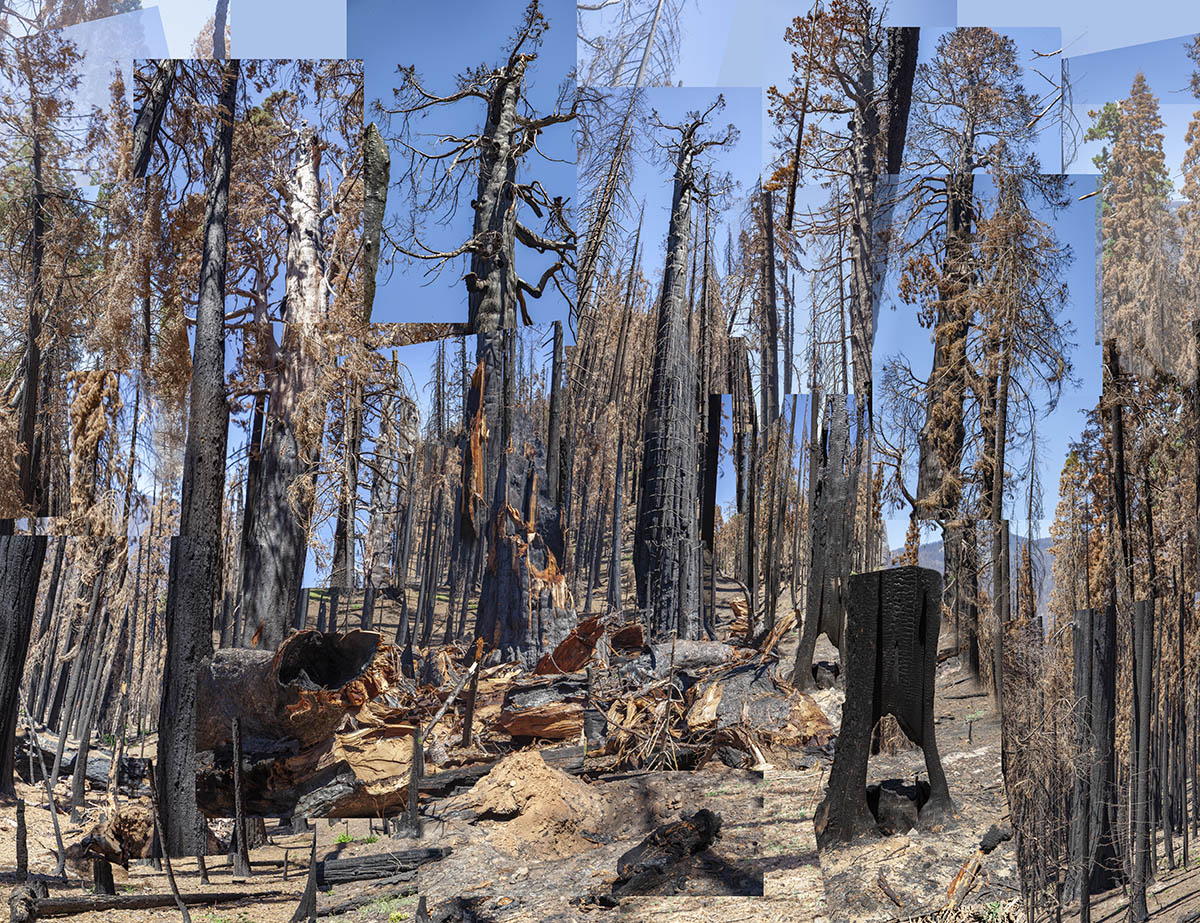
Continuing up the trail, a huge sequoia had shattered. The trunk was sheared off, revealing the brown interior with massive shards of the tree scattered on the ground. At the edge of ridge, any trace of the trail vanished. The fire had scorched as far as I could see.
I made my way back down the slope to where the tree had splintered and stepped off the trail to find a shard where I could sit, touch the tree, touch all of the death and loss on my in breath and breathe out soft gentleness and warmth.
It was impossible to tell how old this tree was when it died, but many of their neighbors had surely been over a thousand years old. A thousand years. All of the models of future climate only go to the end of the current century, long past when I would no longer be alive, my daughter perhaps, if she is gifted with a very long life. Imagine a thousand years of frozen winters, spring rebirth and summer sun. Only about ten percent of the foliage of a sequoia needs to be spared fire for them to survive. Looking up, a couple of the sequoias in the distance might have a chance to pass their wisdom to the next generation, perhaps live for another thousand years.
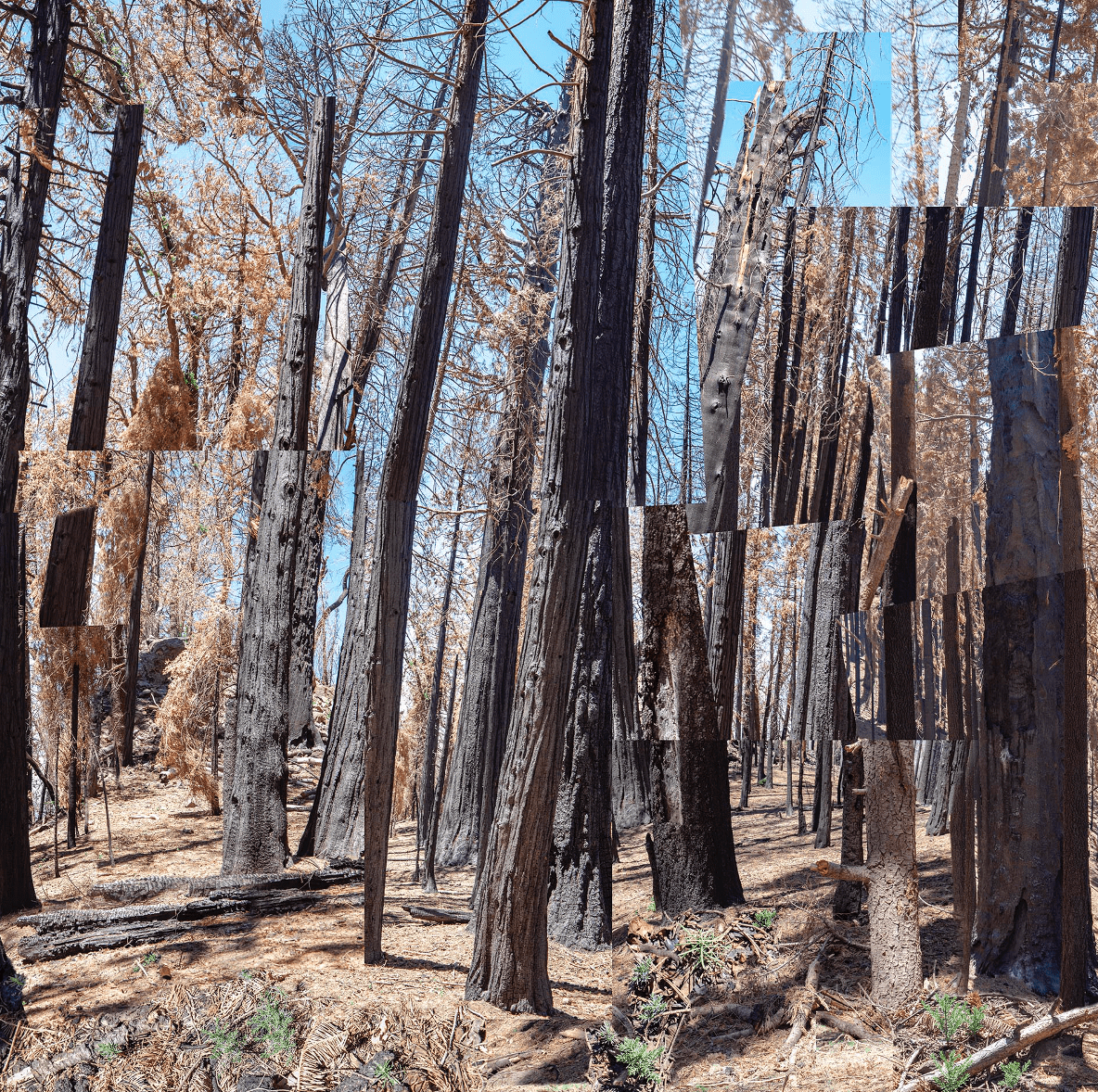
But the earth is calling us to look down. The seedlings at my feet were less than two inches tall. Sequoia seeds only germinate after fire. Despite those who say that the fire burned so hot that it destroyed all of the seeds, here they were by the thousands, demonstrating the continuous life force energy of the earth.
Now these seedlings are asking for a commitment, to be passed from generation to generation of human beings, to nurture the new generation of sequoia over the next thousand years.
To nurture the seedlings, we must nurture the earth. This was where the Harrison’s work started years ago—making compost—honoring, repairing the life web.
Some things are obvious: Refrain from cutting the remaining old growth or clear cutting to preserve integrity of ecosystem both above and below ground. As the Harrison’s noted in the Serpentine Lattice, speak for all areas that have been clear cut.
Speak also for the sterile orchards of Central Valley. Whenever I’ve driven through the valley enroute to the Sierras, the air has been so choked with smoky haze that it is a marvel that the fruit trees could grow at all.
Think like a sequoia seedling; think in tree time. Instead of using up the airable soil in next fifty years, imagine nurturing it for next thousand.
Instead of extracting carbon and burning it in the atmosphere it can be stored in the soil. Instead of poisoning the earth and waterways with pesticides and fertilizers and rupturing the soil fabric with periodic tilling, releasing more greenhouse gases into the atmosphere, we can enrich the soil with compost, mulch and a variety of ground cover plants that increase soil carbon.
Instead of sterile monoculture, intercropping trees with a variety of plants allows each to contribute to the complex whole, adding minerals, fixing nitrogen, and improving soil composition. Creating hedgerows that provide windbreaks establishes microclimates and shelters wildlife, providing habits for the natural enemies of pests.
From backyards to commercial agricultures of the Central Valley, these techniques can be employed in ways appropriate to the scale of the enterprise.
Let us nurture the tiny seedlings.The knowledge is available; it is the commitment and economic incentives that are lacking.Let us commit to nurturing the next generation over the next millennium.
Coda
The trees are crying with ever increasing urgency. On the way home in August 2021, I stopped at the Trail of a Hundred Giants in the Long Meadow, wanting, even if briefly, to walk with healthy sequoias. I had also hoped to visit the sequoias in Sequoia Kings Canyon National Park further north later in the summer. But before I could plan a trip, two new fires, the Windy and KNP complex were burning both portions of Sequoia National Park that I visited in 2020 and the Long Meadow Grove. It is estimated that in two summers, 13-19% of all living sequoias have burned.[19]
A summer later, in July 2022, at the time of submitting this article for publication, already the Washburn fire has threatened the Mariposa grove in Yosemite. A valiant effort appears to have been successful in diverting the flames away from the sequoias. But while the Washborn fire is yet to be fully contained, a new rapidly growing fire, the Oak fire, has erupted in a different part of Mariposa County, and the fire season has barely begun.[20]
The tall sequoias that survive the fires are calling us to think more expansively. Fire too is calling. As it clears the underbrush, may it also clear away existing prejudices and spark fresh imagination.
In this context, it is fortuitous that the only volume of a long list of references about fire that I found shelves of the UCSD library was Forgotten Fires, by Omer C. Stewart.[21] Not only does the book provide profuse documentation of the importance of fires to indigenous peoples throughout the United States, but the editors of the posthumously published volume, Henry T. Lewis and M. Kat Anderson, provide telling introductions that outline the prejudices of anthropologists and ecologists that contributed to fifty-year publication delay. At the time when the manuscript was originally submitted, most anthropologists as well as much of the general public held a linear idea of human evolution. The possibility that indigenous peoples would systematically use fire to “improve” the health of the forest and prevent catastrophic fires was unthinkable to a western audience. Many twentieth century ecologists viewed the forest that they encountered as “pristine,” with climax vegetation growing in a steady state, unaware that in many places this “steady state,” was maintained by indigenous burning practices.
The legacy of being wedded to continuous technological progress while at the same time viewing the forest in static equilibrium, has not only resulted in dense overgrowth, but the vast emissions of greenhouse gases warming the planet, both of which are fueling the huge fires. Current forest managers recognize the need to let fires burn when it is safe to do so and to greatly the number of controlled burns. In California they are beginning to partner with indigenous tribes.[22] But even if it were possible to burn on the scale that is thought necessary, that wouldn’t restore the health of the forests. Even if precipitation increases from that in recent years, which is possible as predictions of future rainfall in California vary, the drought won’t fully abate. Models of future climate under any emissions scenario all concur that temperatures will continue to rise increasing the need for water, since transpiration and evaporation increase with temperature.
It is not too late to learn from indigenous peoples to give praise, to thank mother earth for all that she provides and to recognize that all living beings spring from this earth. It is not too late to be attentive to the seedlings that are calling us to nurture the ground at our feet, to honor the life web, and to commit to all that is entailed in caring for these seedlings for the next thousand years.
Ruth Wallen is a multi-media artist and writer whose work is dedicated to encouraging dialogue around ecological and social justice. After working as an environmental scientist, she turned to art to pose questions beyond disciplinary boundaries, address values informing environmental policy, and contribute to the developing field of ecological art. Solo exhibitions include Franklin Furnace and CEPA in New York, New Langton Arts in San Francisco, and many venues in southern California. She has been represented in numerous national and international group exhibitions ranging from Virgin Territory, at the Long Beach Museum of Art, to Weather Report: Art and Climate Change, curated by Lucy Lippard for the Boulder Museum of Contemporary Art. Web site hosts have included the California Museum of Photography and the Exploratorium, where her work is on view. Her current work bears witness to the tremendous loss of trees over the last decade, providing space for both collective mourning and revisioning ways of being and doing that support the flourishing of the life web. Active in the border region, she was a member of the multinational artist collective Las Comadres, and a Fulbright Lecturer at the Autonomous University of Baja California, Tijuana. Currently she is core faculty for the MFAIA in Interdisciplinary Arts program at Goddard College and a lecturer at University of California, San Diego. In spring of 2022, she was the Lenz fellow at Naropa University in Boulder Colorado and in the fall an artist-in-residence at the Santa Fe Art Institute.
Notes
[1] https://www.ruthwallen.net/art/the-sea-as-sculptress
[2] Thanks to Michael Dettinger, Alexander Gershunov, Richard Somerville, Suraj Polade, Leroy Westerling and Park Williams. See https://www.ruthwallen.com/listentotrees/technical-notes.html
[3] Griffin and K. Anchukaltis, “How unusual is the 2014-2016 drought?” Geophysical Research Letters, 41, 9017-9023. (2014).
[4] https://www.ruthwallen.com/listentotrees/wildcard1.html
[5] Suzanne Simard, Finding the Mother Tree: Discovering the Wisdom of the Forest (New York: Alfred A. Knopf; 2021).
[6] Nina Karavasiles and Ruth Wallen, “Pushing up Daises,” https://www.ruthwallen.net/art/web-works
[7] Francis Weller, “Letting Grief Open Us to Grace,” A New Republic of the Heart, May 23, 2020,
https://newrepublicoftheheart.org/podcast/030-francis-weller-letting-grief-open-us-to-grace/ See also Francis Weller, The Wild Edge of Sorrow: Rituals of Renewal and the Sacred Work of Grief (Berkeley: North Atlantic Books, 2015.)
[8] https://zenpeacemakers.org/the-three-tenets/
[9] Martín Prechtel, The Smell of Rain on Dust: Grief and Praise (Berkeley: North Atlantic Books, 2015), p. 128.
[10] Martín Prechtel, The Smell of Rain on Dust, p. 36.
[11] Philippe Aries, “Invisible Death,” The Wilson Quarterly 5 no. 1 (1981), p. 111.
[12] Renee Lertzman, Environmental Melancholia: Psychoanalytic Dimensions of Engagement (New York: Routledge, 2015), p. 4.
[13] Ruth Wallen, Embracing Ecological Grief,” in Ecoart in Action: Activities, Case Studies and Provocations for Classrooms and Communities, edited by Amara Geffen, Ann Rosenthal, Chris Fremantle and Aviva Rahmani (New York: New Village Press, 2022).
[14] https://workthatreconnects.org/spiral. Last accessed July, 25, 2022.
[15] Pauline Boss, The Myth of Closure: Ambiguous Loss in a Time of Pandemic and Change, (New York: W.W. Norton and Company, 2022), p. 70.
[16] Joanna Macy and Chris Johnstone, Active Hope: How to Face the Mess We’re in without Going Crazy (Novato, Ca.: New World Library, 2022), p. 5
[17] Nathan Stephenson and Christy Brigham, “Preliminary Estimates of Sequoia Mortality in the 2020 Castle Fire,” version: 25 June 2021. https://www.nps.gov/articles/000/preliminary-estimates-of-sequoia-mortality-in-the-2020-castle-fire.htm. Last accessed July, 22, 2022.
[18] Edmund Burke, from “Part I, Section XV111: The Recapitulation,” A Philosophical Inquiry into the Origin of our Ideas of the Sublime and the Beautiful. 1759. https://web.english.upenn.edu/~mgamer/Etexts/burkesublime.html
[19] Kristen Shive, Christy Brigham, Tony Caprio and Paul Hardwick, “2021 Fire Season Impacts to Giant Sequoias” https://www.nps.gov/articles/000/2021-fire-season-impacts-to-giant-sequoias.htm and Nathan Stephenson and Christy Brigham, “Preliminary Estimates of Sequoia Mortality in the 2020 Castle Fire, version: 25 June 2021 https://www.nps.gov/articles/000/preliminary-estimates-of-sequoia-mortality-in-the-2020-castle-fire.htm. Last accessed July, 22, 2022.
[20] https://www.eastbaytimes.com/2022/07/22/wildfire-erupts-mariposa-county-cal-fire-oak-fire/. Last accessed July, 22, 2022.
[21] Omar C. Stewart, Forgotten Fires: Native Americans and the transient wilderness edited and with introductions by Henry T. Lewis and M. Kat Anderson (Norman: University of Oklahoma Press, 2022).
[22] https://grist.org/fix/conservation/indigenous-fire-practices-hot-topic-california/ Last accessed July, 25, 2022.

